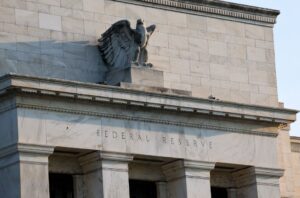Is the nation on the brink of a significant economic downturn? A US recession has been made the base case for Wall Street. In theory, it makes sense. The Federal Reserve is removing the spiked punch bowl by raising interest rates and offloading its trillions in Treasury and corporate bonds, effectively cooling off the sizzling economic landscape by killing demand. At the same time, inflation remains elevated, consumers are taking on debt to survive, and the metrics are screaming recession. And yet, the labor market is still extremely tight, the purchasing managers’ index (PMI) readings are rebounding, and the gross domestic product keeps expanding. So, what’s going on? Make it make sense, please!
The Atlanta Fed Bank’s GDPNow model estimate for the first quarter is 2.6%. The Philadelphia Fed Bank’s Survey of Professional Forecasts suggests 0.6% in the January-March period. Many of the major banks have upgraded their Q1 projections higher. So then, why are the leading indicators howling to the heavens about a US recession? Perhaps to figure this out, assessing these measurements and determining what is happening in the broader economic and political realm is imperative.
Is a US Recession Coming?
For the first time since September 1981, the widely watched spread between the two- and ten-year Treasury yields sank to -107 basis points on Mar. 8. The worsening spread was primarily driven by a rising yield in the two-year note, which topped 5% for the first time since before the 2008-2009 financial crisis. This is a crucial gauge since investors and traders are anticipating higher interest rates in the short term amid slowing economic growth and rate cuts in the long term. Moreover, it has predicted nearly every US recession since the Second World War.
Even the Fed’s preferred recession gauge tumbled. The spread between the three-month and ten-year Treasury yields plunged to -108 basis points, which is still up from the -132 basis points in January 2023. The reason for the notable gap? A fellow named Jerome Powell, the Chairman of the Federal Reserve. He delivered the central bank’s semi-annual Monetary Policy Report to the Senate Banking Committee and the House Financial Services Committee, confirming that the benchmark federal funds rate (FFR) could be higher than policymakers initially believed. Powell clarified to Rep. Andy Barr (R-KY) on Mar. 8 that the terminal policy rate might exceed 5.5%.
Put simply, the inversion deepens each time the Fed illustrates a more hawkish tone on the FFR.
What makes this affair fascinating is that the US central bank and the financial markets had been penciling in and signaling the Fed slowing down the pace of rate hikes and potentially hitting the pause button on quantitative tightening. But the disinflation trend has started slowing in the last couple of months. The January consumer price index (CPI), producer price index (PPI), and personal consumption expenditures (PCE) price index all came in hotter than expected. Powell also alluded to core services inflation excluding housing, an inflation measurement containing everything from travel and leisure to medical services that is showing zero signs of coming down.
Although early estimates aver the annual inflation rate will further ease to 6.2%, components point to upward pressure again. Input costs are re-accelerating, according to the S&P Global manufacturing, composite, and services PMIs. Energy prices are creeping higher, while many food items are elevated or edging up. The Manheim Used Vehicle Value Index, which tracks used vehicle prices, shows that previously owned automobiles surged 4.3% month-over-month in February.

(Photo by Kevin Dietsch/Getty Images)
At the same time, the Eccles Building has been afforded the opportunity to be more aggressive, mainly because the US labor market continues to be robust. Job openings are above ten million, the private sector added more than 200,000 positions in February, and the unemployment rate is at a 54-year-low. This is why some Fed members have proposed front-loading rate hikes or, at the very least, employing larger increases at the upcoming Federal Open Market Committee (FOMC) policy meetings. The financial market ostensibly agrees. According to the CME FedWatch Tool, investors now mostly expect a half-point boost to the FFR, which is a dramatic shift from just a week ago when everyone was penciling in a quarter-point increase.
Other recession indicators are flashing red, too. For example, the Conference Board’s Leading Economic Index (LEI), which assesses a broad array of aspects of the economy, including credit conditions, the labor market, and the yield spread, deteriorated again in January. The LEI slipped by 0.3% to kick off the year, meaning the six-month period is now down 3.6%. “The Conference Board still expects high inflation, rising interest rates, and contracting consumer spending to tip the US economy into recession in 2023,” said Ataman Ozyildirim, the senior director of economics at the Conference Board, in a statement.
The Fed’s M2 money-supply growth contracted for the second consecutive month in January, sliding 1.73%. This is the first time there has been a decline in the amount of money flowing through the economy since the central bank started publishing this data. For many economists of the Austrian persuasion, this is a red flag for the economy and market, especially after such a historical injection of liquidity during the coronavirus pandemic.
Crash and Burn

(Photo by Beata Zawrzel/NurPhoto via Getty Images)
Despite the FOMC raising interest rates by 425 basis points since March 2022, the real FFR (inflation-adjusted) remains negative. So, in a way, it could be argued that the central bank is still proffering easy money to the junkies on Wall Street and Main Street. This may have facilitated the gains in the equity arena this year, or perhaps institutional and armchair traders thought the worst was over, taking Powell’s word in his last few post-FOMC news conferences.
That said, the champagne bottles will soon be empty because some market experts are predicting a sharp crash on the New York Stock Exchange this spring and a US recession this year. The Bear Traps Report founder Larry McDonald told the Fox Business Network on Mar. 8 that the stock market would crash in the next 60 days, citing “our 21 Lehman systemic risk indicators.” David Rosenberg, the founder of independent research firm Rosenberg Research & Associates Inc., thinks a recession is a “lock.”
So far, the economic data were not precisely forecasting a dire financial crisis on par with the financial meltdown more than a decade ago. However, the year is still young, and higher rates will need to travel through the US economy. In the meantime, everyone can point and laugh at those occupying the Eccles Building for getting everything brutally wrong since the COVID-19 public health crisis.




